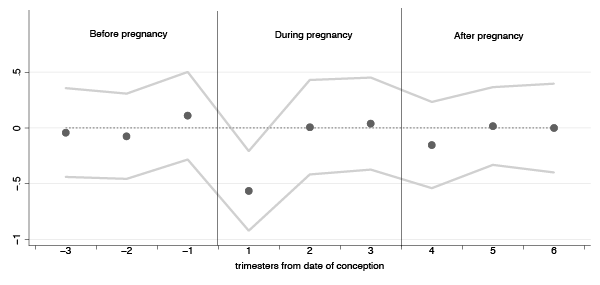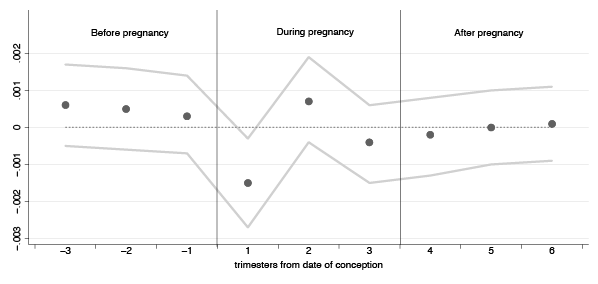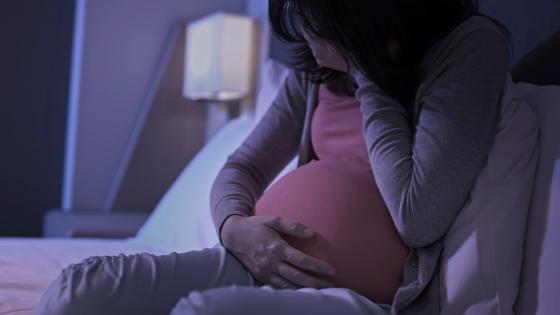Crime often is high on individuals’ agendas when it comes to public policy. Despite the economic downturn, crime takes a very prominent role as the most pressing problem in 12 out of 17 Latin American countries, as documented in the most recent Latinobarometer (2015), with respondents reporting that they are as afraid of “crime” and “gangs” as they are about “unemployment”, “poverty” and the “economy”. Recent research shows that local area crime can even manifest in mental health issues such as depression and anxiety (Dustmann and Fasani 2015). Anxiety possibly may affect the unborn child if expectant mothers are exposed to day-to-day crime, but to date little is known about how day-to-day violence may impact the health of newborns.
Early childhood environment during the nine month in utero has been widely acknowledged by researchers in economics as a crucial period in child development impacting both birth outcomes and longer-term outcomes, including educational attainment, labour market performance, later life health, and mortality (Almond and Currie 2010). Recent research has established a causal link between these outcomes and in-utero exposure to air pollution (Chay and Greenstone 2003, Currie and Walker 2011), poor maternal health including infections (Almond 2006, Barreca 2010) and economic shocks and poor maternal nutrition (Almond et al 2011, Almond and Mazumder 2011, Amarante et al 2016).
More recently this framework has been expanded by investigating how stressful life events during the time in utero affect health and later life outcomes of the unborn children through maternal stress. In particular, extreme events linked to terrorism have been of interest to researchers, including the effect of landmine explosions in Colombia (Camacho 2008), ETA bomb casualties (Quintana-Domeque and Rodenas 2014) or even the 9/11 attacks in New York (Ecclestone 2012). Similarly, other research has looked at the effect of large secular rises in violence, for example due to the onset of conflict (Mansour and Rees 2012). What this research has in common is that it looks at extreme and relatively rare events, and the estimated effects are difficult to generalise to settings of day-to-day violence.
Evidence from day-to-day violence in Brazil
In a departure from the literature that focuses on rare events or the onset of the escalation in violence, our recent paper provides evidence from the exposure to day-to-day violence in Brazil (Foureaux Koppensteiner and Manacorda 2016). For this purpose we analyse birth outcomes of children whose mothers were exposed to local violence as measured by homicide rates in small Brazilian municipalities and the neighbourhoods of the city of Fortaleza. We estimate the effect of violence on birth outcomes by comparing mothers who were exposed to a homicide during pregnancy to otherwise similar mothers residing in the same area, who happened not to be exposed to homicides. As these mothers are likely to live in very similar environments, we exploit the precise timing of the homicides to disentangle the causal effect from other correlated effects that may otherwise bias estimates.
We find that birth weight falls considerably among newborns exposed to a homicide during pregnancy, and the number of children classified as being low birthweight (<=2,500g) increases. The effects are concentrated on the first trimester of pregnancy, which is consistent with claims in the medical literature that stress-induced events matter most when occurring early in pregnancy. We find that homicides at later stages of pregnancy do not affect birth outcomes; we also find that homicides happening after birth do not affect birth outcomes (as by construction these homicides should not matter), helping us to test our estimation strategy. Figure 1 shows the effect of exposure to homicides for the three trimesters before conception, for the three trimesters of pregnancy, and for the three trimesters after birth. Only the first trimester of pregnancy shows a significant negative effect on the birth weight of exposed children.
Figure 1. The effect on birth weight by trimester since conception
Notes: Dots denote the estimated coefficients by trimester; the grey lines denote the 95% confidence interval.
- One additional homicide in small municipalities during the first trimester leads to a reduction in birthweight of around 17g.
- Considering the birth weight classification, one extra homicide leads to an increase in the probability of low birthweight by 0.6 percentage points, an 8% increase compared to baseline.
- Results for the neighbourhoods of Fortaleza, where homicides are much more frequent, are considerably smaller (around 15% of the effects for small municipalities), which is consistent with the interpretation that violence is more stress inducing when it is rare.
We provide evidence that these effects on birthweight are driven by prematurity rather than growth retardation of full length pregnancies, in line with evidence from the medical literature. Figure 2 shows the estimates on gestational lengths by trimester, and the effect focused on the first trimester of pregnancy with no significant effects for any other trimester.
Figure 2. The effect on gestational length by trimester since conception
Notes: Dots denote the estimated coefficients by trimester; the grey lines denote the 95% confidence interval.
We also find that socioeconomic factors, such as the mothers’ low level of education appear to amplify the adverse consequences of violence on birth outcomes, implying that violence compounds the disadvantage that newborns from low socio-economic status already suffer. A possible explanation for this difference is that mothers with higher levels of education may have ways to buffer the adverse consequences of shocks during pregnancy.
Because of the endemic levels of violence in Fortaleza, our calculations show that homicides can account for 1% of the incidence of low birthweight and 3.5% of the incidence of very low birthweight.
Concluding remarks
Our results have the potential to generalise to other settings where violence is endemic, as is true for many middle and low-income countries in Latin America and Africa. The results presented shed light on the additional cost of violence, largely ignored previously, in these countries.
References
Almond, D (2006), “Is the 1918 influenza pandemic over? Long‐term effects of in utero influenza exposure in the post‐1940 US population”, Journal of Political Economy, 114 (4): 672-712.
Almond, D H and J Currie (2010), “Human capital development before age five”, in Handbook of Labor Economics, 4.
Almond, D H, W Hoynes and D Schanzenbach (2011), “Inside the war on poverty: ‘The impact of food stamps on birth outcomes”, Review of Economics and Statistics, 93 (2): 387-403.
Almond, D and B Mazumder (2011), "Health capital and the prenatal environment: The effect of Ramadan observance during pregnancy", American Economic Journal: Applied Economics, 3(4): 56-85.
Amarante, V, M Manacorda, E Miguel and A Vigorito (2016) “Do cash transfers improve birth outcomes? Evidence from matched vital statistics, social security and program data”, American Economic Journal: Economic Policy, forthcoming.
Barreca, A (2010) “The long-term economic impact of in utero and postnatal exposure to malaria”, Journal of Human Resources, 45 (4): 865-892.
Chay, K and M Greenstone (2003) “The impact of air pollution on infant mortality: Evidence from geographic variation in pollution shocks induced by a recession”, The Quarterly Journal of Economics, 118 (3): 1121-1167.
Currie, J and R Walker (2011) “Traffic congestion and infant health: Evidence from E-ZPass”, American Economic Journal: Applied Economics, 3(1): 65-90.
Dustmann, C and F Fasani (2015) “The effect of local area crime on mental health”, The Economic Journal, forthcoming.
Ecclestone, M (2012) “In utero exposure to maternal stress: Effects of 9/11 on birth and early schooling outcomes in New York City”, mimeo. Cambridge, US.
Foureaux Koppensteiner, M and M Manacorda (2016) “Violence and birth outcomes: Evidence from homicides in Brazil”, CEP Working paper DP1323.
Latinobarometer (2015) Annual Report, Latinobarómetro Corporation, Santiago, Chile.
Mansour, H and D Rees (2012) “Armed conflict and birthweight: Evidence from the Al-Aqsa intifada”, Journal of Development Economics, 99: 413-436.
Quintana-Domeque, C and P Rodenas (2014) “Fear in the womb: the effects of terrorism on birth outcomes in Spain”, mimeo. University of Oxford.





